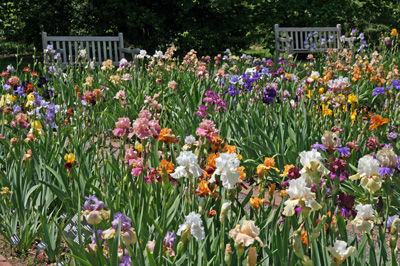
Bearded iris are a great addition to the garden for their beautiful flowers in spring and their bold, vertical foliage. These plants need to be divided every few years, when flowering declines or the clump becomes crowded. This may occur in as little as two years or as many as five. Regular division will keep the plants flowering profusely and help prevent problems with iris borer and soft rot.
Bearded iris can be divided any time after flowering; this is often done in July or August in the Midwest so the replanted portions will have plenty of time to develop new roots and become established before freezing weather arrives.
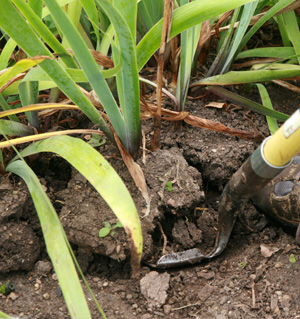
Lift clumps of iris carefully using a shovel or pitch fork. If the soil is dry, water the bed thoroughly a day or so beforehand to make digging easier. The heavy, but shallow-rooted rhizomes are generally easy to see, making it fairly easy to avoid injuring the rhizomes when digging. If possible, lift the entire clump as a whole rather than breaking it up. Shake off the loose soil from the clumps. If your garden soil is fairly loose, you should be able to get most of the soil off the roots, but you can rinse off any remaining soil with a garden hose if necessary.
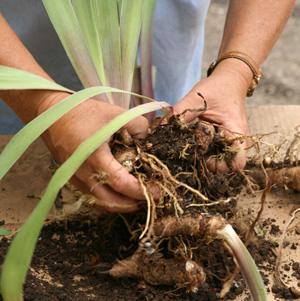
Separate individual rhizomes by pulling apart tangled sections. Inspect the rhizomes carefully for signs of iris borer damage and soft spots from disease. (If the plants had dark streaks on the leaves, then the rhizomes likely are infested with borers. The female borer moth lays its eggs on the leaves in the fall and the young caterpillars tunnel down the leaves to get to the rhizomes, leaving tell-tale streaks behind on the leaves. The plump, pink mature caterpillars generally leave the rhizomes in August to pupate in the soil.) Extract and kill any borers you find and use a clean sharp knife or pruning shears to cut out any damaged parts. Disinfect the cutting tools between cuts to prevent the spread of disease. Also, eliminate any older, spongy growth.
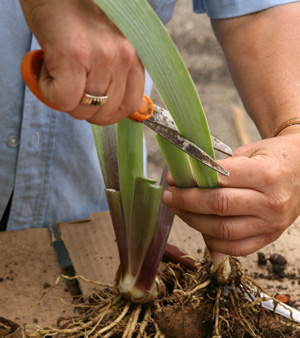
Remove any damaged leaves, then cut the remaining leaves back to 4-6 inches long or 1/3 their original height. This not only makes it easier to work with the plant but also helps reduce transpiration while the plant is becoming re-established. The leaves are often cut symmetrically on an angle but there is no real requirement to cut them in a certain way.
Use a clean knife or pruning shears to cut the rhizomes apart. Make the cuts at natural divisions in the rhizomes, such as where it has forked. Make sure each piece is firm and light colored, at least 3″ long, has healthy roots, and has a fan of leaves on it. Trim any broken or torn roots (scissor work well for this).

To help prevent infection, rhizomes can be soaked for about half an hour in a 10% bleach solution, if desired. They can also be treated with sulfur dust or an insecticide and/or fungicide if pest problems are severe – but this is usually not necessary. Soaked plants should be held in a shady place until dry.
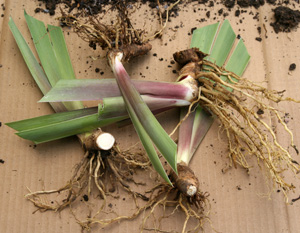
Allow the cut rhizomes to cure for a few hours or days – to allow the cuts to heal over – before replanting. The rhizomes can be stored in paper bags for a while but survival is best when replanted soon after dividing.
Bearded iris should be grown in a sunny location with good drainage. If replanting in the same location, remove any debris and incorporate compost first. Space the divisions 12-18″ apart. Iris are often placed in groups of three divisions arranged in a triangle, with each fan of leaves pointing away from the other irises in the group.
To plant the rhizomes, prepare a shallow hole with a low mound in the center. You may add bone meal to the bottom of the hole but since iris are not heavy feeders additional fertilizer is not needed in all soils. The rhizome should be placed horizontally on the mound, spreading the roots down the mound into the surrounding trench. The plant will grow from the end which has the fan of leaves, so point the rhizome accordingly in the direction you want it to grow. Then fill in the hole, leaving the top of the rhizome barely exposed or just covering it with no more than an inch of soil.
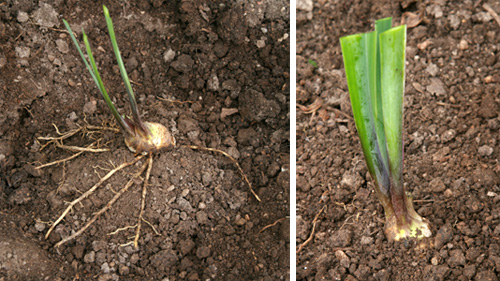

Bearded iris is susceptible to root rot if buried too deeply. Tamp down the soil and water thoroughly after planting. Keep the soil moist but not wet until new foliar growth occurs. Newly planted iris should be mulched their first winter (after the ground freezes) to prevent damage to the rhizomes from alternate freezing and thawing. Remove the mulch in early spring. Transplanted iris will only bloom sparsely the first spring after replanting.
– Susan Mahr, University of Wisconsin – Madison
Latest Horticulture News
Ask Your Gardening Question
If you’re unable to find the information you need, please submit your gardening question here:





 Alternatives to Lawn: Groundcovers
Alternatives to Lawn: Groundcovers Marigolds
Marigolds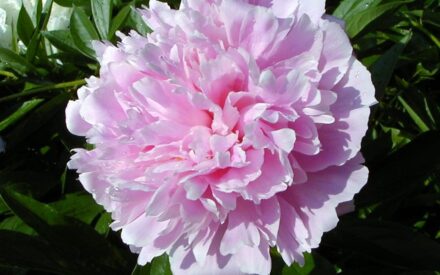 Peony
Peony Iris Severe Mosaic
Iris Severe Mosaic


